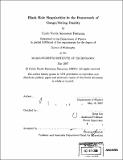Black hole singularities in the framework of gauge/string duality
Author(s)
Festuccia, Guido Nicola Innocenzo
DownloadFull printable version (9.470Mb)
Other Contributors
Massachusetts Institute of Technology. Dept. of Physics.
Advisor
Hong Liu.
Terms of use
Metadata
Show full item recordAbstract
In this dissertation black hole singularities are studied using the AdS/CFT correspondence. These singularities show up in the CFT in the behavior of finite-temperature correlation functions. A direct relation is established between space-like geodesics in the bulk and momentum space Wightman functions of CFT operators of large dimensions. This allows to probe the regions inside the horizon and near the singularity using the CFT. Information about the black hole singularity is encoded in the exponential falloff of finite-temperature correlators at large imaginary frequency. We also find a UV/UV connection that governs physics inside the horizon. For the case the bulk theory lives in 5 dimensions the dual theory is an SU(N) Yang-Mills theory on a sphere, a bounded many-body system. The signatures of the singularity we found are only present as N -+ oo. To elucidate the emergence of the singularity in the gauge theory we further study the large N limit. We argue that in the high temperature phase the theory is intrinsically non-perturbative in the large N limit. At any nonzero value of the 't Hooft coupling A, an exponentially large (in N2) number of free theory states of wide energy range (or order N) mix under the interaction. As a result the planar perturbation theory breaks down. We argue that an arrow of time emerges in the gauge theory and the dual string configuration should be interpreted as a stringy black hole.
Description
Thesis (Ph. D.)--Massachusetts Institute of Technology, Dept. of Physics, 2007. Includes bibliographical references (p. 201-209).
Date issued
2007Department
Massachusetts Institute of Technology. Department of PhysicsPublisher
Massachusetts Institute of Technology
Keywords
Physics.